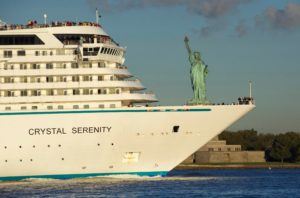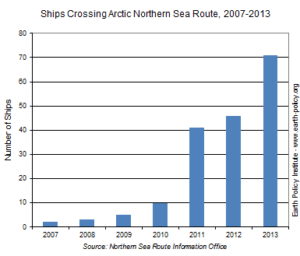Cruising to the Arctic? That’s Ironic…

Cruise lines are striving to minimize the environmental impact of their operations while at the same time pursuing opportunities created by climate change. How can they reconcile the apparent contradiction?
Waterparks, 5,000-person floating communities, ice skating rinks, promenades, and endless buffets are but a few of the many things people associate with cruises. If it sounds too good to be true, then you’re right. However, all this fun at sea comes at a cost to the environment as cruising generates significant waste which affects both the air and the water. According to the EPA, an average cruise ship emits the same amount of sulfur dioxide as 13.1 million cars combined on a given day.[1] Regarding waste, an average cruise ship with 3,000 passengers and crew produces 21,000 gallons of sewage which adds up to over one billion gallons of waste a year for the industry.[2] Even the cruise lines themselves do not dispute their environmental impact, and many of them, including Crystal Cruises, have deliberate and comprehensive plans for reducing pollution, complying with environmental regulations, and improving systems to minimize their negative environmental impacts.
These efforts are all well documented and not considerably different from actions taken by many other companies in a diverse set of industries to reduce their own carbon footprints. But, while Crystal is undoubtedly a contributor to the global increase in “greenhouse gas” emissions and has adjusted its operations accordingly, there is a unique silver lining in that climate change and its subsequent effects also present Crystal and the cruise industry with a new opportunity. In this case, it is a new frontier…the Arctic!
The Northwest Passage is the famed route connecting the Atlantic and Pacific Oceans. Until 2007, Arctic sea ice made the passage almost unnavigable. But, because of climate change and the subsequent warmer temperatures, in 2007, the passage became ice free in the late summer months.[3] Businesses see this as a growth opportunity and the cruise industry, specifically Crystal Cruises, has been at the forefront.
In 2013, recognizing the potential opportunity, Crystal Cruises CEO, Edie Rodriguez, set out an ambitious plan for the company to charter a luxury cruise ship through the Northwest Passage. Three years later, on August 15, 2016, the Crystal Serenity set sail from Seward, Alaska on a lengthy journey up through the Bering Strait, along the Northern coast of Canada, past Greenland, and finally down the eastern seaboard of the United States. On September 16th, 2016, the Crystal Serenity arrived in New York, completing the 32-day journey and becoming the first voyage of its kind.[4] Given the trailblazing and uncertain nature of the expedition, Crystal approached preparations and operations very differently than it ordinarily does. For instance, from the beginning of planning, there was intense coordination between a Crystal expert team and several expedition partners. The vessel was escorted by the RRS Ernest Shackleton which served multi-purpose functions, such as a first response vessel in case of emergency, as well as an ice breaker, and helicopter carrier. Additionally, the Serenity was equipped with forward looking sonar, ice searchlights, ice radar, and a thermal imaging system.[5]
While there was a great deal of press coverage celebrating the historic nature of the trip, it was not all positive. As noted above, cruise ships negatively impact the environments in which they operate given their carbon emissions and waste dumping. Not surprisingly, many were quick to point out these seriously harmful effects and the potential for a magnified impact in such an environmentally fragile region as the Arctic. Critics recognized that, while Crystal Serenity may have been the first, it is only the beginning as the Northwest Passage is opening itself up to all kinds of traffic (yachts, cruises, cargo ships, etc.). Ships crossing the Arctic Northern Sea Route increased seven-fold just from 2010-2013.[6]
There is evidently a business opportunity here, and if Crystal does not capitalize on it, then someone else will. However, given the environmental vulnerabilities of the Arctic as well as the cruise industry’s indisputable existing environmental impact, Crystal must proceed carefully. There is an obvious irony and tension in recognizing your role as a contributor to climate change and putting policies in place to mitigate those impacts, while also pursuing a business opportunity that only exists because of climate change. As such, Crystal needs to enhance its efforts to minimize and reduce the environmental impact of its operations. There appears to be significant room for improvement as Friends of the Earth rated Crystal Cruises toward the very bottom in its 2016 Cruise Ship Report Card which rates cruise lines on their environmental footprints.[7] Additionally, Crystal needs to be more proactive versus simply adhering to current standards and regulations. They should strive to add value to the Arctic instead of simply minimizing harm. This will not only give Crystal a competitive edge over competitors as regulations tighten but will also help Crystal combat critics who claim it is hypocritical in its actions.
Word Count (789)
[1] https://www.washingtonpost.com/national/health-science/cruise-ship-lines-alaska-officials-question-new-air-pollution-limits/2012/07/22/gJQAc4Jy2W_story.html
[2]http://www.foe.org/news/news-releases/2016-06-disney-cruise-line-regains-a-grade-for-pollution-transparency
[3] ]http://www.climatecentral.org/news/ice-free-northwest-passage-20624
[4] http://www.businesswire.com/news/home/20160916005705/en/Mission-Accomplished-Crystal-Serenity-Completes-32-Day-Northwest
[5] Ibid.
[6] https://thinkprogress.org/arctic-biggest-cruise-ship-ever-ea7b71e9844f#.huz9sw6bv
[7] http://www.foe.org/cruise-report-card







Really interesting article! I believe you have done a great job in explaining the tensions inherent to the new business opportunities for the cruise industry. Although I agree with the fact that Crystal should invest time and money to find ways in which to add value to the Arctic, are there no ways to leverage the coverage gained by the trip as a way to create awareness? I would argue that as long as they plan to continue to offer this new route, they should be partnering with researchers and NGOs in order to provide their facilities as a platform from which people could further understand the effect climate change has on this most vulnerable area. To my understanding, access to the Arctic is still difficult and expensive, so being the facilitator could better position them as a sustainable company although their own operations would have to be adapted in some degree to the needs of the partners they would choose.
Thank you for the insightful and thought provoking article. It is sad to read how much negative impact these type of vessels have on the environemnt and how much harm we humas produce to just enjoy a few days of holiday on a ship in the sea. Your post on Crystal Cruises shows than not only this company is polluting the world, it intends to seize the business opportunities climate change offers it to pollute us even more. So I wonder what can be done to limit this huge amount of CO2 emissions generated by the cruise industry as a whole? A few initial thoughts come to my mind:
1. Impose strict regulations that would require cruise these companies to reduce their emissions to a specific amount. I suppose it will be a challenging task as such restrictions might need to be imposed on Shipping industry as well, thus resulting in a much higher impact on the world`s economy.
2. Building on 1 above, force these companies to cooperate with the renewable energy developers to find ways to significantly cut the emissions. For example, would it work to build the vessel from solar panel materials (similar to what Solar City wants to do for rooftops) and thus become more efficient?
3. Make people aware of what happens to the environment every time they on-board such a ship. For example, regulators can require companies to say that the journey of each passenger is equivalent in terms of CO2 emissions to 12 years of driving a car everyday [13.1m/3000passengers/365days]. And then link this amount of CO2 to the number people who suffer because of that. I believe people do not necessarily have a link yet on how pollution results in real health and social problems.
Happy to discuss any other possible solutions.
I really enjoyed reading your thought-provoking blog post. I think you did a really great job of explaining the tension between greenhouse gas emissions and revenue generation in the tourism industry. In your post, you mention that Crystal needs to (1) reduce the environmental impact of its operations and (2) be more proactive (beyond merely adhering to regulation). However, given the inherent tension between business objectives and environmental impact, I wonder if Crystal would be willing to make this investment. Namely, are there ways in which the two goals (reduced environmental impact and increased business opportunities) are NOT at odds with one another?
I like the suggestions that Eugenio outlined, especially the third idea, because it’s something the company can do without regulatory pressure. In addition, I wonder how continued rising temperatures would affect Crystal’s business model. Would an increase in global temperatures destroy some of the natural beauty in the Arctic, thus decreasing tourism? If so, this might be a compelling reason for Crystal to invest resources in combating climate change.
Happy to discuss further and thanks again for your thoughtful post!